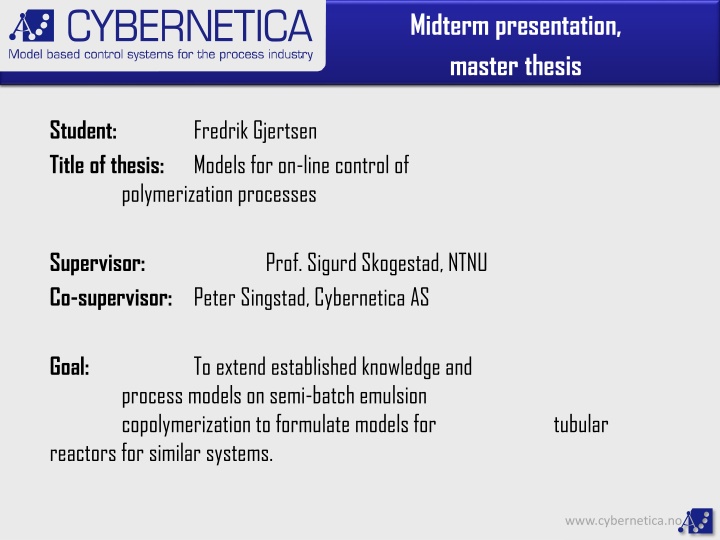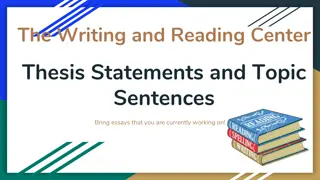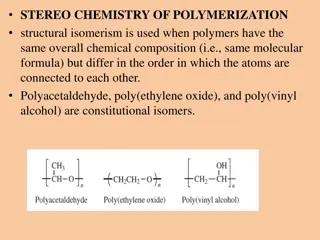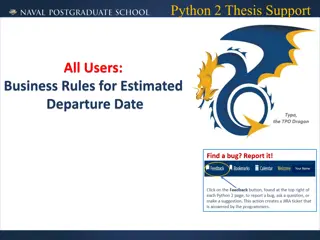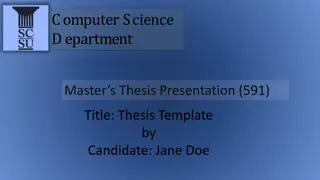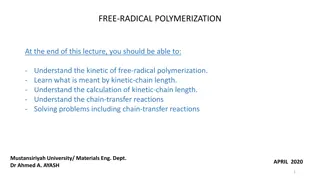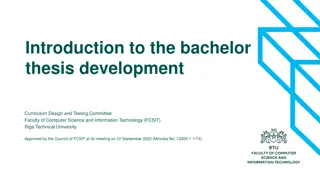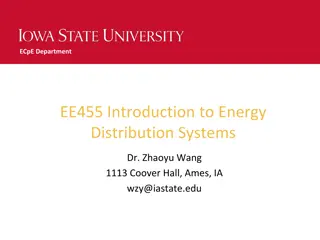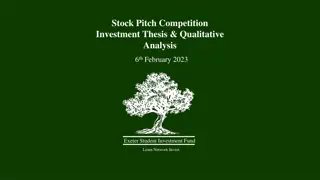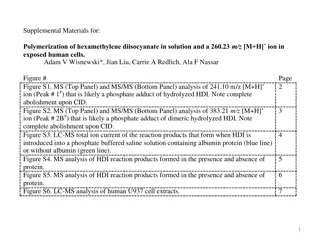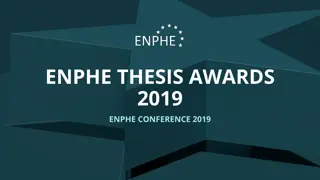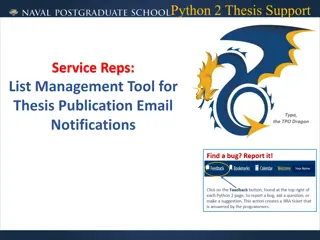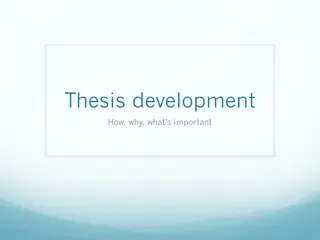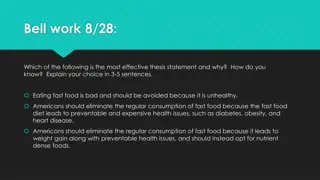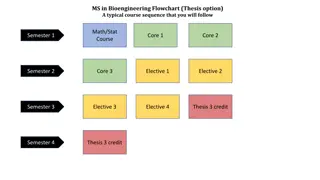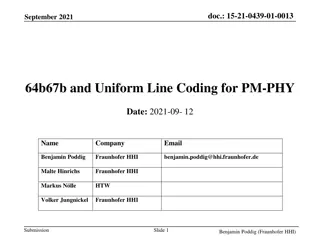Models for On-line Control of Polymerization Processes: A Thesis Presentation
This presentation delves into developing models for on-line control of polymerization processes, focusing on reactors for similar systems. The work aims to extend existing knowledge on semi-batch emulsion copolymerization models, with a goal of formulating models for tubular reactors. Strategies, background, purpose, mathematical modeling, and implementation thoughts are highlighted, emphasizing the use of numerical methods and experimental data to establish efficient models for optimization and control.
Uploaded on Sep 12, 2024 | 2 Views
Download Presentation

Please find below an Image/Link to download the presentation.
The content on the website is provided AS IS for your information and personal use only. It may not be sold, licensed, or shared on other websites without obtaining consent from the author.If you encounter any issues during the download, it is possible that the publisher has removed the file from their server.
You are allowed to download the files provided on this website for personal or commercial use, subject to the condition that they are used lawfully. All files are the property of their respective owners.
The content on the website is provided AS IS for your information and personal use only. It may not be sold, licensed, or shared on other websites without obtaining consent from the author.
E N D
Presentation Transcript
Midterm presentation, master thesis Student: Title of thesis: Fredrik Gjertsen Models for on-line control of polymerization processes Supervisor: Co-supervisor: Peter Singstad, Cybernetica AS Prof. Sigurd Skogestad, NTNU Goal: reactors for similar systems. process models on semi-batch emulsion copolymerization to formulate models for To extend established knowledge and tubular www.cybernetica.no
Agenda The background for the work The purpose of the thesis work Strategies towards achieving proper process models Results so far Thoughts on how to implement the models in an on-line simulator for optimization and control 2
Background Same chemical process as previously studied Emulsion copolymerization Summer internship & specialization project Previously studied as a semi-batch process Part of the European research project COOPOL The semi-batch reactor setup is the setup of primary interest, but new reactor setups, i.e. tubular reactors are also explored. 3
Purpose of the work The purpose of the work is to establish an efficient model for a smart-scale tubular reactor to be used for on-line optimization and control. Modeling approaches: - Finite differences (The Numerical Method of Lines) - Incremental model with variable transformation, yielding a model of moving control volumes Mass diffusion effects for the reactor are explored using experimental RTD data, and the established models are compared to this. For the purpose of continuous reactors, micellar nucleation is included in the model as an alternative to seeded polymerization. 4
Mathematical modeling Starting point: An arbitrary volume, for which the amount of an arbitrary (intensive) quantity ( ) is considered. = ??? ????????? ???? ???????? + ??? ?????????? ??? ???????????? ?? ???????? (a shell balance is an alternative approach to the exact same result) ? ?? ? ?? = ?? ? ?? + ? ?? ? ? ? ?? ?? + ? ?? = ? ?? ?? + ? ???? = ? ?2? ??2 + ? ?? ?? + ? ????? = ?? 5
A quick summary The tubular reactor is described by partial differential equations in both time and space More complexity introduced, compared to semi-batch setup System(s) of ordinary differential equations is preferred What strategy should be used to reduce the model? Discretization in space should be performed Numerical efficiency is important Using experimental RTD data for the reactor, the mixing effects of the reactor can be accounted for in each case (each model) Is the effective mass diffusion negligible? 6
Approach 1: Finite differences (referred to as the NMOL approach) Partial differential equations are discretized in space, yielding ordinary differential equations in time for each discrete position. This strategy is referred to as the Numerical Method of Lines, which is a traditional approach to solve partial differential equations. In practice, this approach is similar to the well-known tanks-in-series strategy model. Calculations show that a large amount of discretization points is needed This may constitute a problem with respect to implementing the model on-line 7
Approach 1: Finite differences Approximation based on Taylor series: ?? ?? ?2? ??2 Tanks in series RTD: ? ??+1 ? ?? ? ? ??+1 2? ?? + ?(?? 1) ?2 ? ?? 1 ? 1 ! 1 ? ? ? ? ? = ? 8
Residence time distribution, finite differences In doing an RTD experiment using an inert tracer compound, the required number of tanks in series, i.e. the spacing of the spatial discretization, can be determined. Calculations show that a large amount of discretization points is needed 9
Transformation of variables Running an inert tracer compound through the reactor can indicate the RTD of the reactor. Note: No net generation of inert in the reactor. Transformation of the model equations to an alternative coordinate system: ?2?? ??2 ??? ?? + ? ?????? = ?? ? = ? ??? ? = ? ?2? ? ?? 2 ?? ? ?? = ?? The equation is now separable, and can be solved analytically. Important: This specific equation is for an inert tracer component only, and the equation will be more complicated for a reacting species. 10
Residence time distribution, change of variables Simulation with effective diffusivity adjusted: 11
Approach 2: Mobile (finite) control volumes (referred to as the MCV approach) Each discrete control volume behaves like a (small) traditional batch reactor, with ordinary differential equations in time for the model equations. The positions of the control volumes vary throughout the reactor. ?? ?? = ? The control volumes are not physically connected, meaning that model outputs at specific points in space, e.g. reactor outlet, must be the result of an interpolation. Experimental RTD can be utilized to determine the size and internal spacing between the moving reactor units. How many units are needed, and how large (long) should they be? 12
Thoughts on controller implementation Numerical stability and efficiency Some parts of the model are sensitive to stiffness A low demand for computational effort is desired Functioning estimator The estimator must run smoothly and not intervene with the ordering of moving control volumes in the MCV approach. The controller tuning is not trivial/obvious 14
Controller performance simulation strategy Measured plant behavior Controller action Controller and estimator algorithms, governed by a numerically efficient model. Plant* representation, governed by a less numerically efficient, but perhaps more accurate, model. * In this work, the plant is the isolated behavior of the single reactor in mind. 15
Summary The NMOL model is less numerically efficient than the MCV model. In order to get satisfying performance for the NMOL approach, the number of discretization points needs to be significantly lower than what the RTD experiments suggest (in order to achieve correct mixing conditions). A proposal is to use the less numerically efficient model (NMOL) as a plant replacement model and the MCV model for on-line control purposes. Next steps: studies. Temperature control, feedrate of monomer, etc. - Off-line parameter estimation using experimental data - Implementation with the Cybernetica CENIT software for control control to achieve better conversion 16
